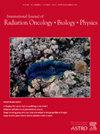使用同步加速器进行质子闪烁辐照:辐照位置的差异。
IF 6.5
1区 医学
Q1 ONCOLOGY
International Journal of Radiation Oncology Biology Physics
Pub Date : 2024-11-15
DOI:10.1016/j.ijrobp.2024.11.066
引用次数: 0
摘要
目的:利用同步加速器质子束加速器建立超高剂量率(UHDR)辐射系统,并比较不同辐照位置对培养细胞和小鸡胚胎的影响:用于超高速辐照的质子是通过施加比通常水平高得多的高频功率来获得的,以便在大约 50 毫秒内提取所有质子。随后,在同步加速器提取后立即用法拉第杯进行监测,并相应调整波形。使用了四种培养肿瘤细胞系、两种正常细胞系和小鸡胚胎。6-18 Gy(200-300 Gy/s,单次照射)的超高剂量率辐射(UHDR-RT)和 6-18 Gy(3 Gy/s)的常规剂量率辐射(Conv-RT)被照射到 1 厘米的扩散布拉格峰(SOBP)和 SOBP 之前的高原区。辐照后,评估细胞生长率和细胞周期进展的差异,并通过集落试验评估细胞存活率。此外,还对小鸡胚胎的存活率进行了检测:结果:UHDR-RT 在 40 到 800 Gy/s 的范围内实现,包括高原期和高峰期。体外研究表明,UHDR-RT 和 Conv-RT 对癌细胞的杀伤效果相似。在 UHDR-RT 峰值条件下,细胞周期中出现了明显的凋亡效应和 G2 停滞。在正常大气条件下,正常单细胞中未观察到 FLASH 效应。与峰值 Conv-RT 相比,暴露于峰值 UHDR-RT 的 V79 球形细胞具有更强的细胞杀伤效应。此外,在小鸡胚胎中观察到存活率增加,这表明了 FLASH 效应:结论:使用同步加速器质子束加速器在小鸡胚胎中进行 UHDR-RT 也能产生 FLASH 效应。峰值 UHDR-RT 对癌细胞的杀伤效果更高,这可能是由于 SOBP 的线性能量转移更高。本文章由计算机程序翻译,如有差异,请以英文原文为准。
Proton FLASH Irradiation Using a Synchrotron Accelerator: Differences by Irradiation Positions
Purpose
To establish an ultra-high dose-rate (UHDR) radiation system using a synchrotron proton beam accelerator and to compare the effects by irradiation positions on cultured cells and chick embryos.
Methods and Materials
Protons for UHDR were obtained by applying high-frequency power at much higher levels than usual to extract all protons within approximately 50 ms. Subsequently, monitoring with a Faraday cup was performed immediately after synchrotron extraction and the waveform was adjusted accordingly. Four cultured tumor lines, 2 normal cell lines, and chick embryos were used. UHDR radiation therapy (UHDR-RT) at 6 to 18 Gy (200-300 Gy/s, single exposure) and conventional dose-rate radiation therapy (Conv-RT) at 6 to 18 Gy (3 Gy/s) were administered to the 1-cm spread-out Bragg peak (SOBP) and the plateau region preceding SOBP. After irradiation, disparities in cell growth rates and cell cycle progression were assessed, and cell survival was evaluated via colony assay. Chick embryos were also examined for survival.
Results
UHDR-RT was achieved at a range of 40 to 800 Gy/s, encompassing both plateau and peak phases. In vitro studies demonstrated similar cell-killing effects between UHDR-RT and Conv-RT in cancer cells. Significant apoptotic effects and G2 arrest were observed during the cell cycle under peak UHDR-RT conditions. The FLASH effect was not observed in normal single cells under normal atmospheric conditions. Stronger cell-killing effects were noted in V79 spheroids exposed to peak UHDR-RT than peak Conv-RT. Moreover, in chick embryos, an increase in survival rate, indicative of the FLASH effect, was observed.
Conclusions
The FLASH effect was also achieved with UHDR-RT using a synchrotron proton beam accelerator in chick embryos. The cell-killing effects in cancer cells were higher with peak UHDR-RT that may be due to the higher linear energy transfer at the SOBP.
求助全文
通过发布文献求助,成功后即可免费获取论文全文。
去求助
来源期刊
CiteScore
11.00
自引率
7.10%
发文量
2538
审稿时长
6.6 weeks
期刊介绍:
International Journal of Radiation Oncology • Biology • Physics (IJROBP), known in the field as the Red Journal, publishes original laboratory and clinical investigations related to radiation oncology, radiation biology, medical physics, and both education and health policy as it relates to the field.
This journal has a particular interest in original contributions of the following types: prospective clinical trials, outcomes research, and large database interrogation. In addition, it seeks reports of high-impact innovations in single or combined modality treatment, tumor sensitization, normal tissue protection (including both precision avoidance and pharmacologic means), brachytherapy, particle irradiation, and cancer imaging. Technical advances related to dosimetry and conformal radiation treatment planning are of interest, as are basic science studies investigating tumor physiology and the molecular biology underlying cancer and normal tissue radiation response.

 求助内容:
求助内容: 应助结果提醒方式:
应助结果提醒方式:


